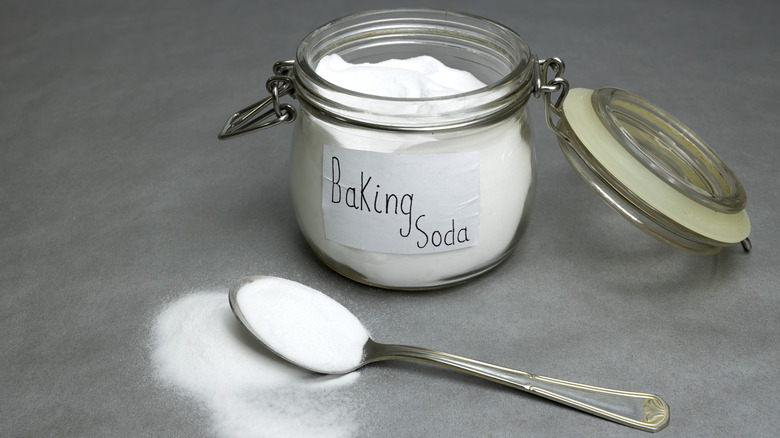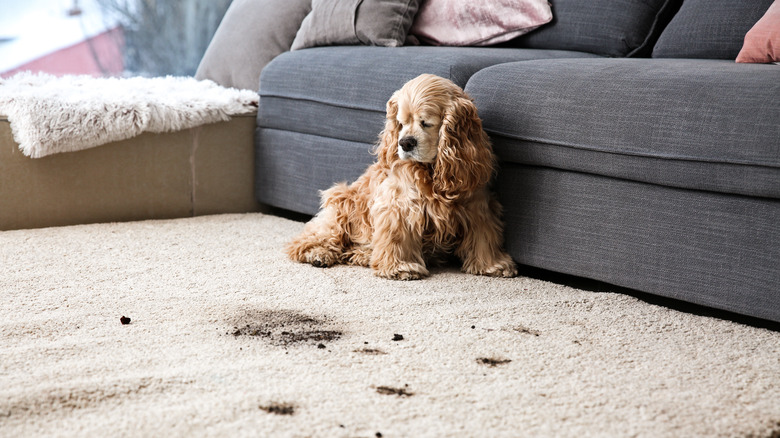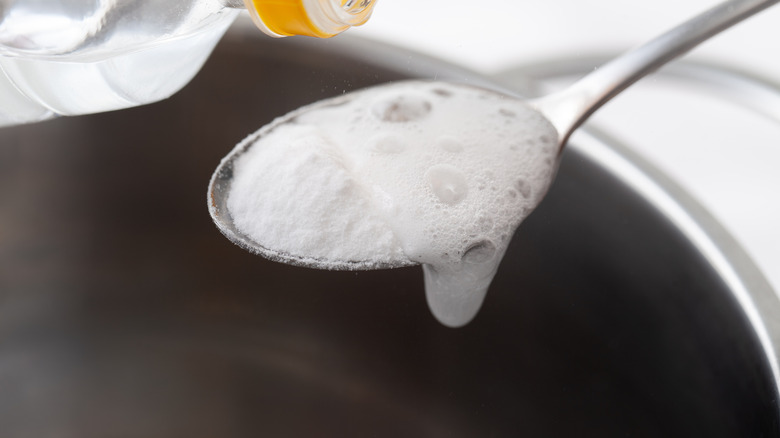The Most Unexpected Way To Use Baking Soda In Your Home
Any cook is likely to be familiar with baking soda's prominent place in baking. The white powder is also commonly used to deodorize refrigerators and clean sinks and drains. Less well-known is its ability to clean and freshen rugs, upholstery, and curtains. Baking soda is also a powerful stain remover. Either solo or in tandem with essential oils or vinegar, baking soda is effective, inexpensive, fragrance-free, and environmentally friendly. As an unexpected fabric and carpet cleaner, its value extends far beyond those chocolate chip cookies.
Baking soda consists solely of sodium bicarbonate. It is an alkaline substance derived from trona, a rock that is the source of soda ash (sodium carbonate). Baking soda is processed from soda ash. It was first put to commercial use in 1846 by a pair of brothers-in-law, according to Everyday Health. By the 1970s, baking soda had become a household essential, basically used for air-freshening purposes. Note: Baking soda is not identical to baking powder.
In baking, baking soda acts as a leavening agent by producing carbon dioxide in response to an acid. This oxidized gas is also a potent stain remover, per Steamy Concepts. Baking soda neutralizes and weakens the acids typically found in stains, and more than simply masking their odors, it neutralizes them, too, asserts EasyClean Solutions. Baking soda is also capable of absorbing liquids such as pet urine, and it serves as a whitening agent as well.
Removing carpet stains
The surprisingly forceful baking soda works equally well on greasy or non-greasy stains, with slight variations in the routine. Before starting the cleaning and deodorizing process, make a preliminary pass with a vacuum cleaner to pick up any particles or debris. Confirming the rug's color-fastness should be the next step, suggests Arm & Hammer. To test it, put a mixture of one-half tablespoon baking soda and a half cup of water onto an obscure part of the carpet. Dry, then vacuum it. If no visible discoloration appears, you are good to go. Blot, don't rub, a greasy stain before starting to clean, and also use a small amount of dish soap if necessary.
For both types of stains, sprinkle a substantial amount of baking soda onto the offending area. For a greasy spot, leave powder on overnight to absorb as much oil as possible. Repeat the process if needed, then thoroughly vacuum. For a greaseless stain, cover the baking powder with a damp cloth or towel and let sit for several hours. Then thoroughly vacuum.
Baking soda can also be used for a daily maintenance program of cleaning and deodorizing your carpets. Lightly dust it onto the carpet and keep it on for 15 minutes. A larger quantity is recommended for areas more frequently trod upon. Vacuum when the time has elapsed. When cleaning stains, Best Cordless Vacuum Guide suggests using a dry bristle brush to spread the baking soda across the rug's surface and fibers before vacuuming.
Deodorizing with baking soda
Vinegar, essential oils, and borax can all be used to complement baking soda's inherent deodorizing power. Oh So Spotless recommends spraying a 2:1 mixture of warm water and vinegar, combined with 2 tablespoons of baking soda directly onto the carpet. A stronger solution of a cup of baking soda, half that amount of borax, and 15 drops of essential oils will refresh even the funkiest carpet. Sprinkle it on instead of spraying, and let sit for several hours.
DIY Natural suggests a different approach using 2 cups of baking soda and 30 drops of essential oil. Pour onto the carpet or rug and let it stew for one or two hours. Vacuum after the allotted time. Antibacterial and calming lavender is their oil of choice, as it is also toddler safe. Its scent can be controversial, so mint or citrus oils are good alternatives if preferred.
While baking soda is an unexpectedly excellent carpet cleaner and deodorizer, there are a few caveats to consider when using it. It should not be mixed with bleach, ammonia, or rubbing alcohol. Excessive amounts of baking soda can potentially damage the surface underneath the floor covering. Air Fresh warns that carpets and pads may need to be replaced if too much of the sodium bicarbonate sticks to them, and vacuums must be up to the task of efficiently suctioning and filtering the particles. On the positive side, the deodorizing baking soda will enhance the appliance's fragrance.


